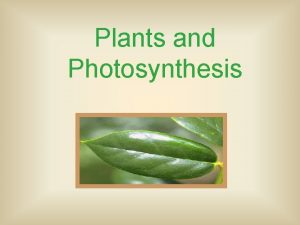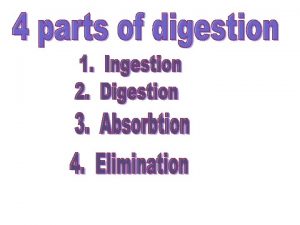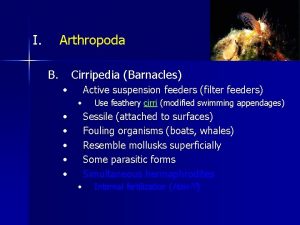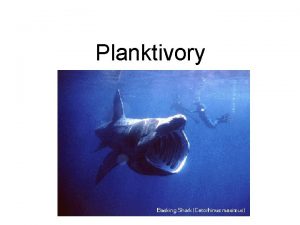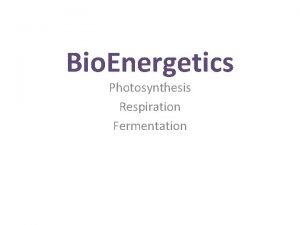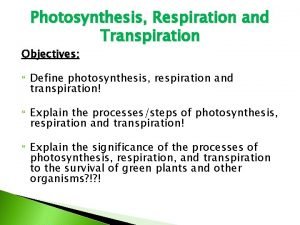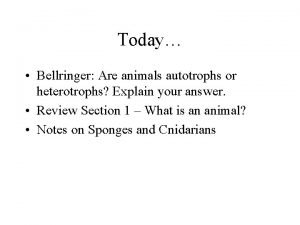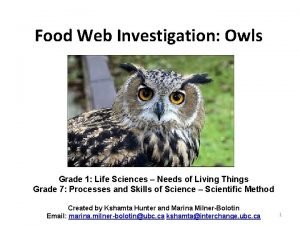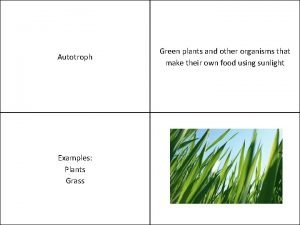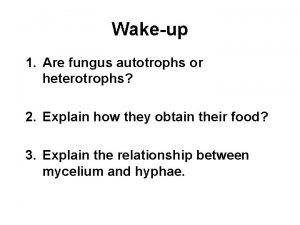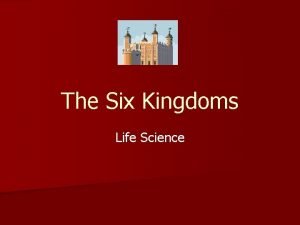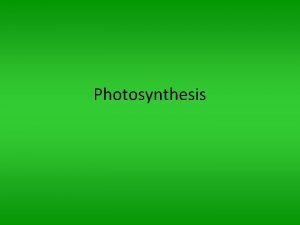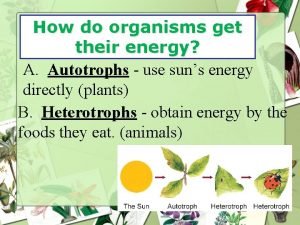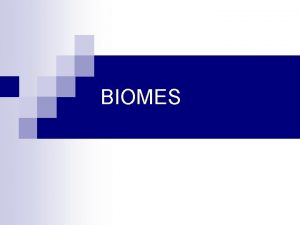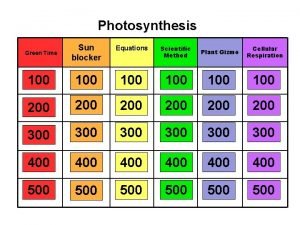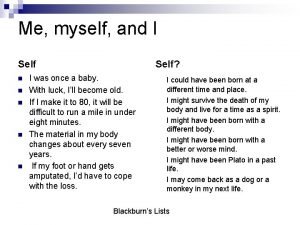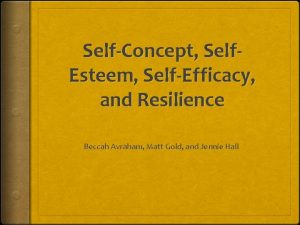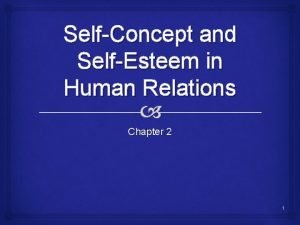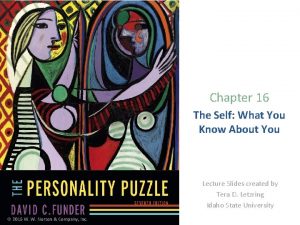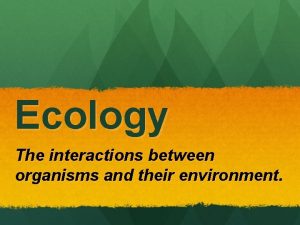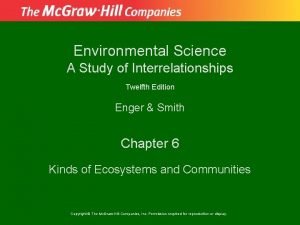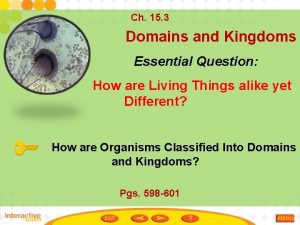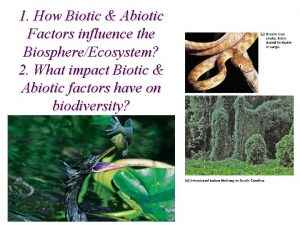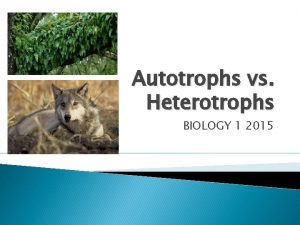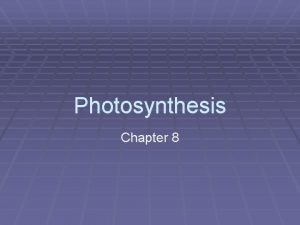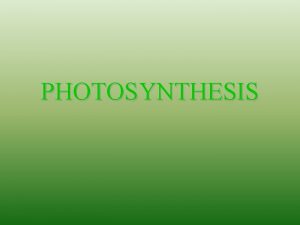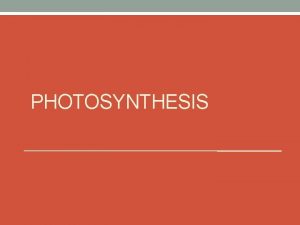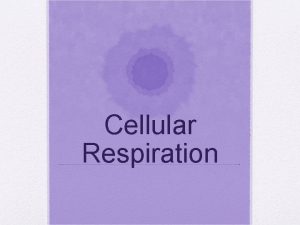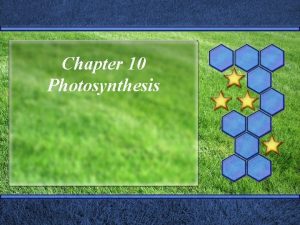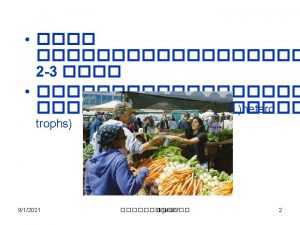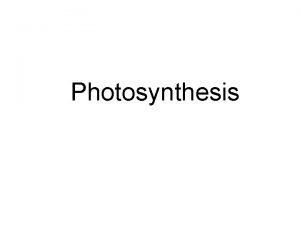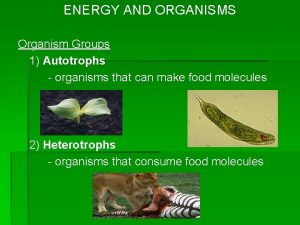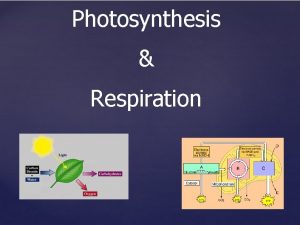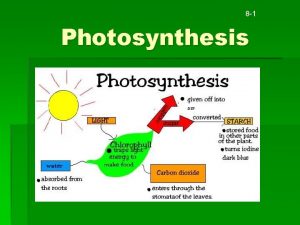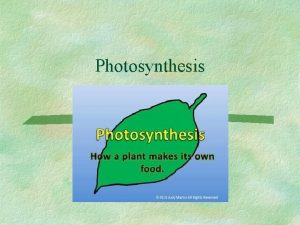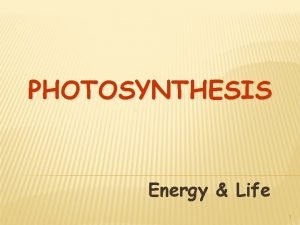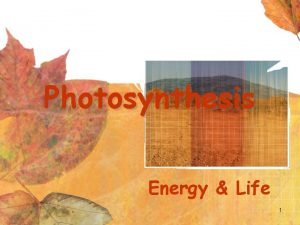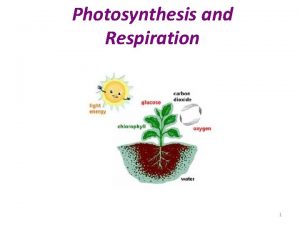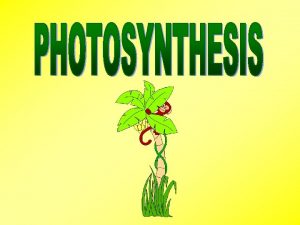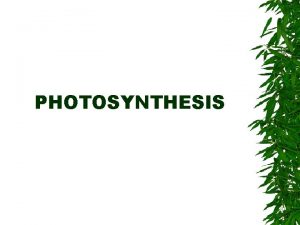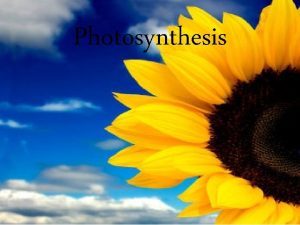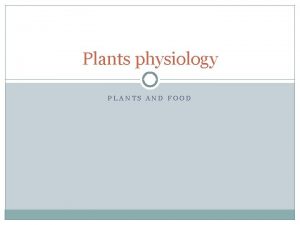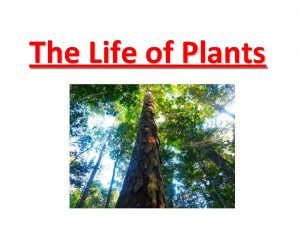Plants and Photosynthesis Photosynthesis Organisms Autotrophs Self Feeders



















































- Slides: 51

Plants and Photosynthesis

Photosynthesis • Organisms –Autotrophs: “Self Feeders” • Photo-: Light • Chemo-: Oxidize inorganics (Ex: Sulfur, Ammonia), unique to bacteria –Heterotrophs: “Other Feeders”

History • Jean-Baptiste van Helmont (1600’s) –grew willow tree • Weighed soil before and after • Added only water –Tree gained 75 kg –No change in mass of soil –Concluded: mass in plants comes from water

History • Joseph Priestly (1770’s) –Showed that plants can live in places animals can’t –Plants could make the air better so animals could live there again • Antoine Lavoisier (1770’s) –Showed that O 2 is removed during burning

History • Other scientists throughout the 1700’s showed: –O 2 is required for burning and for animals to live –plants give off O 2 only in sunlight –plants only take in CO 2 in sunlight • By 1800, scientists knew plants require 3 things for growth: –CO 2, H 20, and Sunlight

Site of Photosynthesis • Parts of a Leaf –Cuticle: prevents water loss –Upper and Lower Epidermis –Guard cells/stomata: control what enters and exits the leaf –Mesophyll Layer • Palisades: Columnar cells • Spongy: round cells surrounded by air spaces

Site of Photosynthesis Upper Epidermis Mesophyll Cells Vein Lower Stoma Epidermis

Site of Photosynthesis • Chloroplast –~ half a million chloroplasts per square millimeter of leaf surface –A typical mesophyll cell has 30 -40 chloroplasts, each about 2 -4 microns by 4 -7 microns long

Site of Photosynthesis • Chloroplast –Inner and outer membranes –Thylakoids – sac-like membranes that hold pigments –Grana – stack of thylakoids –Stroma – fluid outside thylakoids, but still within the chloroplast

Site of Photosynthesis Thylakoids Stroma Granum Inner & Outer Membranes

Photosynthesis Conversion of Light E into Chem E • Light E –Travels in waves (photons) –Wavelength ( ): crest to crest (measured in nm) • inversely related to frequency • Higher frequency = more E –Different = different properties

Nature of Light • Visible spectrum is ~380– 750 nm Gamma Rays Micro- Radio X-Rays. UV Infraredwaves Waves Visible Light 400 450 500 550 600 650 700 Wavelength (nanometers) 750

Nature of Light • Pigments absorb certain and reflect or transmit others

Nature of Light • Spectrophotometers measure amount of Light pigments absorb or reflect

Nature of Light • Pigments –Absorb and reflect light –Specific pigment = specific light –Chlorophylls • a and b – both absorb blues and reds • a is 1 pigment for photosynthesis – focuses solar E onto a pair of e-s

Nature of Light • Accessory pigments – funnel the E they collect to a central Chlorophyll A –Carotenoids • Carotenes – reflect oranges • Xanthophylls – reflect yellows –Phycocyanins – reflect blues • Some accessory pigments provide photoprotection against excess light –Carotenoids in human eyes serve same function

Absorption/Action Spectra Visible Light Chlorophyll Collectively % Light Absorption 400 450 500 550 600 650 700 750 100 80 60 Carotenoids Phycocyan in 40 20 0 400 450 500 550 600 650 700 750 Wavelength (nanometers)

Engelmann’s Experiment • Simple experiment in 1883 • Compare to action spectrum

Photosynthesis • Can be divided into –Light-dependent rxn • Makes E storing compounds NADPH and ATP to fuel L-i rxn • Occurs in thylakoids –Light-independent rxn • Uses NADPH and ATP to produce glucose, a more stable form of E • Occurs in stroma

Photosynthesis

Light-dependent rxn

Light-dependent rxn • Light is absorbed in photosystem II, an “antenna complex” of hundreds of pigments that funnel E to a reaction center • Rxn Center: central chlorophyll a molecule next to a protein, the 1° e- acceptor

Light-dependent rxn • The e-s from the broken bonds slide down the ETC, slowly losing E • The e-s are recharged by sunlight in photosystem I and are passed along more carrier proteins to NADP+, reducing it to NADPH

Photosynthesis

Light-dependent rxn • Photosystem II – P 680 (absorption peak is 680 nm) • Photosystem I – P 700 (absorption peak is 700 nm) • P 700 normally ships its e-s down the ETC to NADP+ (noncyclic e- flow) • Sometimes P 700 will ship the e-s back to the Cytochrome complex (cyclic e- flow) – This pumps more H+ across the thylakoid membrane

Light-dependent rxn

Light-dependent rxn • Chemiosmosis – The lost E from the ETC “pumps” H+ ions from the stroma into the thylakoid, creating a high [H+] in the thylakoid – Diffusion allows the H+ to flow through ATP Synthase to the stroma – This flow of ions through the enzyme generates enough E to phosphorylate ADP to ATP

Light-dependent rxn • Chemiosmosis



sun O 2 H+ H+ Light-dependent H+ H 20 H+ H+ + H H+ H+

Light-dependent sun O 2 ADP H+ ATP H+ H 20 H+ H+ + H H+ H+ H+

Light-dependent rxn summary • H 2 O is broken up by sunlight • O 2 is released as waste • e-s flow down ETC, pump H+ ions, and finally make NADPH • H+ ions diffuse across thylakoid membrane and help form ATP • ATP and NADPH move on to the lightindependent rxn

Light-independent rxn • Called the Calvin-Benson Cycle for the men who discovered it • Also called the C 3 cycle because CO 2 is fixed into a 3 carbon molecule (3 PG) • Calvin Cycle has three phases –Carbon fixation –Reduction –Regeneration of Ru. BP

L-i rxn – C fixation • 6 CO 2 are “fixed” to 6 ribulose bisphosphate (Ru. BP), a 5 C sugar –Process is sped up by Rubisco (Ru. BP carboxylase) • These new intermediates (6 6 C compounds) quickly break into 12 3 C molecules called 3 -phosphoglycerate (3 PG)

L-i rxn – C fixation

L-i rxn – Reduction • 12 ATPs phosphorylate the 12 3 PGs to form 12 1, 3 bisphoglycerates • A pair of e-s from NADPH reduces each 1, 3 bisphoglycerate to glyceraldehyde-3 -phosphate (G 3 P) –The electrons reduce a carboxyl group to a carbonyl group

L-i rxn – Reduction

L-i rxn – Reduction • Two G 3 Ps can now be removed from the cycle to make glucose or be used for as any other carb the plant cell needs

L-i rxn – Regeneration • Only having 10 G 3 Ps is good because now we have the same number of C as we started – just in a different form – 6 ATPs are used to change the ten 3 C G 3 Ps into six 5 C Ru. BPs –And the cycle starts all over again


Light-independent rxn summary • Carbon Fixation –CO 2 binds with Ru. BP and forms 3 PG • Synthesis of G 3 P –ATP and NADPH are used • Regeneration of Ru. BP –Removal of 2 G 3 Ps to make glucose

Photorespiration • Stomata not only allow gas exchange, but transpiration also • Hot, dry day – stomata close –Problem: CO 2 , O 2 • Rubisco can bind either CO 2 OR O 2 to Ru. BP • When O 2 binds, no useful cellular E is produced

Photorespiration • When rubisco adds O 2 to Ru. BP, Ru. BP splits into a 3 -C piece and a 2 -C piece –The 2 -C fragment is exported from the chloroplast and degraded to CO 2 by mitochondria and peroxisomes • Photorespiration decreases photosynthetic output by siphoning organic material from the Calvin cycle • Up to 50% of the C fixed by Calvin cycle can be drained away on a hot, dry day

C 4 Plants • Mesophyll cells use PEP carboxylase to fix CO 2 to phosphoenolpyruvate, forming oxaloacetate (4 C) –PEP carboxylase has a very high affinity for CO 2 and can fix CO 2 efficiently when rubisco cannot - on hot, dry days with the stomata closed

C 4 Plants • Oxaloacetate then dumps the extra CO 2 into the Calvin cycle in bundlesheath cells • Rubisco can then work with a high concentration of CO 2, thus minimizing photorespiration • C 4 plants thrive in hot regions with intense sunlight –Examples: sugar, corn

C 4 Plants

CAM Plants • Crassulacean Acid Metabolism • CO 2 is fixed at night, but NO photosynthesis takes place at night • During the day, the light reactions supply ATP and NADPH to the Calvin cycle and CO 2 is released from the organic acids

CAM Plants • Allows plants to keep their stomata closed during the hot, dry hours of day and open in the cooler hours of night –Less water is lost in the process –Less photorespiration occurs –Ex: succulent plants, cacti, pineapples, and several other plant families

CAM Plants

• Both C 4 and CAM plants add CO 2 into organic intermediates before it enters the Calvin cycle –In C 4 plants, carbon fixation and the Calvin cycle are spatially separated –In CAM plants, carbon fixation and the Calvin cycle are temporally separated • Both eventually use the Calvin cycle to incorporate light energy into the production of sugar
 Autotroph
Autotroph Real and ideal selves
Real and ideal selves Uni and multicellular organisms
Uni and multicellular organisms Are aphids suspension feeders
Are aphids suspension feeders Star feeders
Star feeders West discom
West discom Arthropoda
Arthropoda Continuous feeders animals
Continuous feeders animals Competitive interaction
Competitive interaction Difference between autotrophs and heterotrophs
Difference between autotrophs and heterotrophs How living things obtain energy worksheet answers
How living things obtain energy worksheet answers Photosynthesis definition
Photosynthesis definition Classify the non flowering plants with examples
Classify the non flowering plants with examples Are sponges autotrophs or heterotrophs
Are sponges autotrophs or heterotrophs Burrowing owl food chain
Burrowing owl food chain Autotroph examples
Autotroph examples Heterotroph kingdom
Heterotroph kingdom Creeping stem
Creeping stem What is this animal
What is this animal The six kingdoms
The six kingdoms Autotrophs
Autotrophs Cellular respiration equation
Cellular respiration equation Is eubacteria terrestrial or aquatic
Is eubacteria terrestrial or aquatic The food that plants produce during photosynthesis is
The food that plants produce during photosynthesis is Photosynthesis glossary
Photosynthesis glossary Green plants make their own food by photosynthesis
Green plants make their own food by photosynthesis Vascular vs nonvascular plants
Vascular vs nonvascular plants Non vascular plant reproduction
Non vascular plant reproduction C3 plants vs c4 plants
C3 plants vs c4 plants Section 11.1 the work of gregor mendel
Section 11.1 the work of gregor mendel I self and me self difference
I self and me self difference Self confidence and self awareness eyfs
Self confidence and self awareness eyfs Thomas reid brave officer
Thomas reid brave officer Self concept vs self esteem
Self concept vs self esteem Self concept vs self esteem
Self concept vs self esteem Self image vs self perception
Self image vs self perception Self-concept
Self-concept It is the alignment of the ideal and real self.
It is the alignment of the ideal and real self. Contoh ideal self dan real self
Contoh ideal self dan real self Procedural self-knowledge includes ________.
Procedural self-knowledge includes ________. Kingdom phylum class order of humans
Kingdom phylum class order of humans Section 1 organisms and their relationships
Section 1 organisms and their relationships Living and nonliving things venn diagram
Living and nonliving things venn diagram Organisms and the environment
Organisms and the environment Principles of ecology section 2 flow of energy
Principles of ecology section 2 flow of energy Chapter 2 section 1 organisms and their relationships
Chapter 2 section 1 organisms and their relationships Chapter 2 principles of ecology answer key
Chapter 2 principles of ecology answer key Chapter 2 section 1 organisms and their relationships
Chapter 2 section 1 organisms and their relationships Unicellular vs multicellular
Unicellular vs multicellular Zones in lake ecosystem and types of organisms present
Zones in lake ecosystem and types of organisms present How are organisms classified into domains and kingdoms
How are organisms classified into domains and kingdoms 5 levels of organisms
5 levels of organisms
